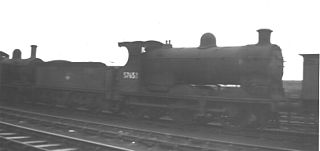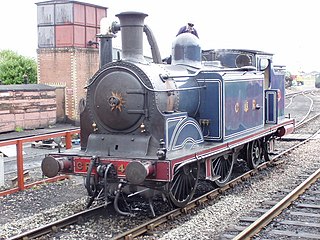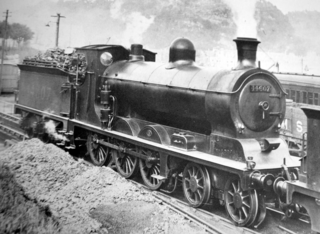The London, Midland and Scottish Railway had the largest stock of steam locomotives of any of the 'Big Four' Grouping, i.e. pre-Nationalisation railway companies in the UK. Despite early troubles arising from factions within the new company, the LMS went on to build some very successful designs; many lasted until the end of steam traction on British Railways in 1968. For an explanation of numbering and classification, see British Rail locomotive and multiple unit numbering and classification.
Sir Henry Fowler, was an English railway engineer, and was chief mechanical engineer of the Midland Railway and subsequently the London, Midland and Scottish Railway.

Richard Edward Lloyd Maunsell held the post of chief mechanical engineer (CME) of the South Eastern and Chatham Railway from 1913 until the 1923 Grouping and then the post of CME of the Southern Railway in England until 1937. He had previously worked his way up through positions in other railways in Ireland, England and India.

The Caledonian Railway 300 Class were freight 0-6-0 tender engines introduced in 1918 and designed by William Pickersgill. Forty-three were built between 1918 and 1920. They were numbered 294–324, 280, 281, 670–679 by the Caledonian Railway.
William Pickersgill was an English railway engineer, and was chief mechanical engineer of the Caledonian Railway from 1914 until Grouping in 1923. He was appointed locomotive superintendent of the Northern Division of the London, Midland and Scottish Railway but retired in 1925. He died in Bournemouth.

Glasgow Works, formerly the St Rollox Works, is a railway rolling stock heavy maintenance and repair works established in the 1850s in the Glasgow district of Springburn by the Caledonian Railway Company, and known locally as 'the Caley'.

The Caledonian Railway 439 Class is a class of 0-4-4T steam locomotive. It was a development of earlier Caledonian Railway 0-4-4T locomotives, including the 19 Class and 92 Class, and predecessor of the 431 Class. The 439 Class was introduced by John F. McIntosh in 1900 and a modified version was introduced by William Pickersgill in 1915.

Dugald Drummond was a Scottish steam locomotive engineer. He had a career with the North British Railway, LB&SCR, Caledonian Railway and London and South Western Railway. He was the older brother of the engineer Peter Drummond, who often followed Dugald's ideas in his own work.

A condensing steam locomotive is a type of locomotive designed to recover exhaust steam, either in order to improve range between taking on boiler water, or to reduce emission of steam inside enclosed spaces. The apparatus takes the exhaust steam that would normally be used to produce a draft for the firebox, and routes it through a heat exchanger, into the boiler water tanks. Installations vary depending on the purpose, design and the type of locomotive to which it is fitted. It differs from the usual closed cycle condensing steam engine, in that the function of the condenser is primarily either to recover water, or to avoid excessive emissions to the atmosphere, rather than maintaining a vacuum to improve both efficiency and power.
Harry Smith Wainwright was an English railway engineer, and was the Locomotive, Carriage and Wagon Superintendent of the South Eastern and Chatham Railway from 1899 to 1913. He is best known for a series of simple but competent locomotives produced under his direction at the company's Ashford railway works in the early years of the twentieth century. Many of these survived in service until the end of steam traction in Britain in 1968, and are regarded as some of the most elegant designs of the period.

Thomas William Worsdell was an English locomotive engineer. He was born in Liverpool into a Quaker family.
Wilson Worsdell was an English locomotive engineer who was locomotive superintendent of the North Eastern Railway from 1890 to 1910. He was the younger brother of T.W. Worsdell. Wilson was born at Monks Coppenhall, near Crewe on 7 September 1850 to Nathaniel and Mary Worsdell; he was their tenth child and fourth son. In 1860 he was sent as a boarder to Ackworth, a Quaker school in Yorkshire.

James Holden was an English locomotive engineer.
Robert Wallace Urie was a Scottish locomotive engineer who was the last chief mechanical engineer of the London and South Western Railway.

John Lambie was a Scottish engineer. He was born in Saltcoats, Ayrshire, on 29 October 1833 and died in Glasgow on 1 February 1895. He was Locomotive Superintendent of the Caledonian Railway from 1891 to 1895.

The Caledonian Railway 721 Class was a class of 4-4-0 steam locomotives designed by John F. McIntosh for the Caledonian Railway (CR) and introduced in 1896. All survived to be absorbed by the London, Midland and Scottish Railway (LMS) in 1923 and a few survived into British Railways (BR) ownership in 1948.
The Caledonian Railway 179 Class and 184 Class were 4-6-0 mixed-traffic locomotives designed by John F. McIntosh and built in two batches in 1913-14 and 1914-15 respectively, at the Caledonian Railway's own St. Rollox Works. The differences between the two batches were minor, and they are often considered to be a single class.

The Caledonian Railway 49 Class and 903 Class were 4-6-0 express passenger locomotives designed by John F. McIntosh and built at the Caledonian Railway's own St. Rollox Works in 1903 and 1906 respectively.

The Caledonian Railway 55 Class were 4-6-0 mixed-traffic locomotives designed by John F. McIntosh and built at the railway’s St. Rollox works in Glasgow in 1902-1905. The class was intended for use on the Callander and Oban line and were sometimes known as Oban Bogies, a nickname they shared with the earlier Brittain 179 Class 4-4-0s and the subsequent Pickersgill 191 Class 4-6-0s, all of which were built for use on the same route.













